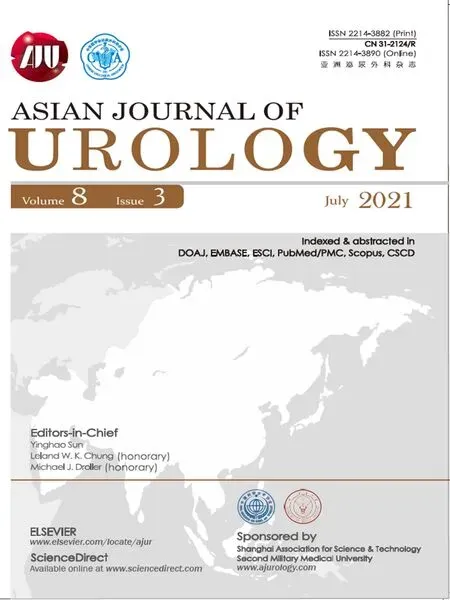Testing for BRCA1/2 and ataxiatelangiectasia mutated in men with high prostate indices:An approach to reducing prostate cancer mortality in Asia and Africa
2021-11-11 05:52:27JudeOgechukwuOkoye
Asian Journal of Urology 2021年3期
Dear Editor,
A recently published review article titled “Current progress and questions in germline genetic of prostate cancer”enumerated some pertinent questions which impact on prostate cancer (PCa) surveillance and management [1].Literature across the world reveals that the agestandardized incidence rate per 100 000 of PCa is lower in Asia (11.5) and Africa (26.6) when compared with Latin America/Caribbean (56.4),Europe (62.1) and Oceania(79.1);surprisingly the mortality rate per new case is higher in Africa (52.2%) and Asia (39.8%) when compared with Europe (23.9%),Oceania (19.1%),and Latin America/Caribbean (16.8%) [2].Globally,screening for prostate-specific antigen (PSA) is an approach aimed at identifying PCa at its early stages.However,early identification of individuals at risk of developing aggressive/lethal PCa remains a challenge among clinicians.A follow-up study carried out in the United Kingdom(UK)and Ireland showed that 4.3%and 5.8%of those carryingBRCA1
andBRCA2
mutations developed PCa with a standardized incidence ratio(SIR)of 2.4 and 4.5,respectively [3].However,the study was not explicit on whether the patients developed lethal or indolent PCa.Another study carried out in the UK revealed that after 3 years of active histological follow-up,5.2%,3.4%,3.0%,and 2.7%ofBRCA2
carriers,BRCA1
carriers,BRCA2
non-carriers,andBRCA1
non-carriers developed aggressive PCa,respectively [4].Nyberg et al.[3] observed that those with a positive family history have SIR of 3.2 and 7.3 forBRCA1
andBRCA2
while those with a negative family history have SIR of 2.3 and 3.9 forBRCA1
andBRCA2
,respectively.In the United State(US),a 26 years follow-up exercise revealed that 13.0%of actively monitored men developed PCa,out of which 13.9% developed aggressive PCa [5].Evidence showed that the frequency of pathogenic mutations was higher in patients with aggressive PCa (6.1%) than in patients with localized PCa (1.4%) [6].The frequency ofBRCA1
,BRCA2
,and ataxiatelangiectasia mutated (ATM
) were higher in aggressive PCa (0.6%,3.5%,and 1.9%) than in localized PCa(0.4%,0.8%,and 0.4%,respectively).This suggests that apart fromBRCA2
mutation,BRCA1
mutation and ATM play critical roles in the development of aggressive carcinogenesis.However,the extent to which the germline mutations drive carcinogenesis differs with race and across continents.Na et al.[6] showed that carrier rates of pathogenic mutations ofBRCA1/2
,ATM
,and DNA repair genes(DRGs
)are higher in Chinese (0.0%/13.6%,4.6%,and 18.2%) than in Caucasians(0.8%/3.1%,1.5%,and 5.4%) and African American (0.0%/0.0%,3.3%,and 3.3%,respectively).Chandrasekar et al.[7]observed that the prevalences of hereditary breast and ovarian cancer (HBOC),hereditary cancer syndrome (HCS),and hereditary prostate cancer(HPC)were higher in African American than in Caucasians while the prevalences of Lynch syndrome (LS) was higher in African American than in Caucasians,with differences of 7.2%,4.2%,1.2% and 3.5%,respectively.They observed that the prevalence of HCS,HBOC,and LS connected to family history were higher in African American than in Caucasians with a difference of 12.6%,15.6%,and 15.6%,respectively.From their study,the prevalences ofBRCA1
andBRCA2
were higher in African American (14.3% and 3.6%,respectively) than in Caucasians(5.0% and 3.5%,respectively) while the prevalence ofATM
was higher in Caucasians (0.7%) than in African American(0.0%).The increasing mortality rate among PCa patients has resulted in a robust search for reliable prostate indices to identify individuals at high-risk of developing lethal,aggressive or metastatic PCa.Some of the prostate indices are Gleason score (GS),prostate volume,PSA density and level,and prostate-specific membrane antigen (PSMA) expression.Evidence showed that patients with prostate volume <60 g were more likely to have high-risk PCa (Gleason grade group>4) [8] while PSA density of >2.0 ng/mL had the best complementary sensitivity and specificity to predict pathological adverse disease [9].Paschalis et al.[10]stated that the frequency of PSA level >3.0 ng/mL was higher inBRCA2
carriers than inBRCA2
non-carriers(7.5% versus 5.8%,respectively) [4].Similarly,high expression of membranous PSMA,driven by increased demand for folate and glutamate,in patients with metastatic castration-resistant PCa was associated withBRCA2
mutation.An earlier study revealed that germline mutation carriers had a significant higher frequency of GS≥7 and higher median PSA levels (71%;7.90 ng/mL) than their non-carriers counterparts (31%;6.20 ng/mL) [6].AmongBRCA2
mutation carriers,patients with GS≥7 had higher SIR (5.1) than patients with GS≤6 (3.0) [3].Higher frequency of mutation carrier rate in patients with aggressive PCa was associated with lower age of death (≤70 years) and shorter survival time [6].Taken together,these findings suggest that germline mutation inBRCA2
gene remains a strong predictor of aggressive PCa and poor survival outcome.Extensive study of germline mutations has been carried out in African American,Caucasians,Hispanics and Asians,especially those with aggressive PCa;sadly there is a paucity of data on the prevalence of the mutations in African men.To avoid overdiagnosis,men (≤70 years) with a family history of breast,ovarian,or pancreatic cancers or LS should be tested for abnormal PSA level to aid early detection of PCa.To reduce PCa related mortality in Asia and Africa,men with reduced prostate volume,high PSA density and levels,and high PSMA expression should be tested for germline mutations in DRGs.Conflicts of interest
The author declares no conflict of interest.
 Asian Journal of Urology2021年3期
Asian Journal of Urology2021年3期
- Asian Journal of Urology的其它文章
- Male genital damage in COVID-19 patients:Are available data relevant?
- A comparison of artificial urinary sphincter outcomes after primary implantation and first revision surgery
- Augmented anastomotic urethroplasty with buccal mucosa for post penile fracture urethral injury long segment bulbar urethral stricture review
- The neutrophil-tolymphocyte ratio at the prostate-specific antigen nadir predicts the time to castration-resistant prostate cancer
- Conquering new battlegrounds:Successful management of isolated giant retrovesical hydatid cyst with robotic assistance
- A systematic review of dedicated models of care for emergency urological patients
